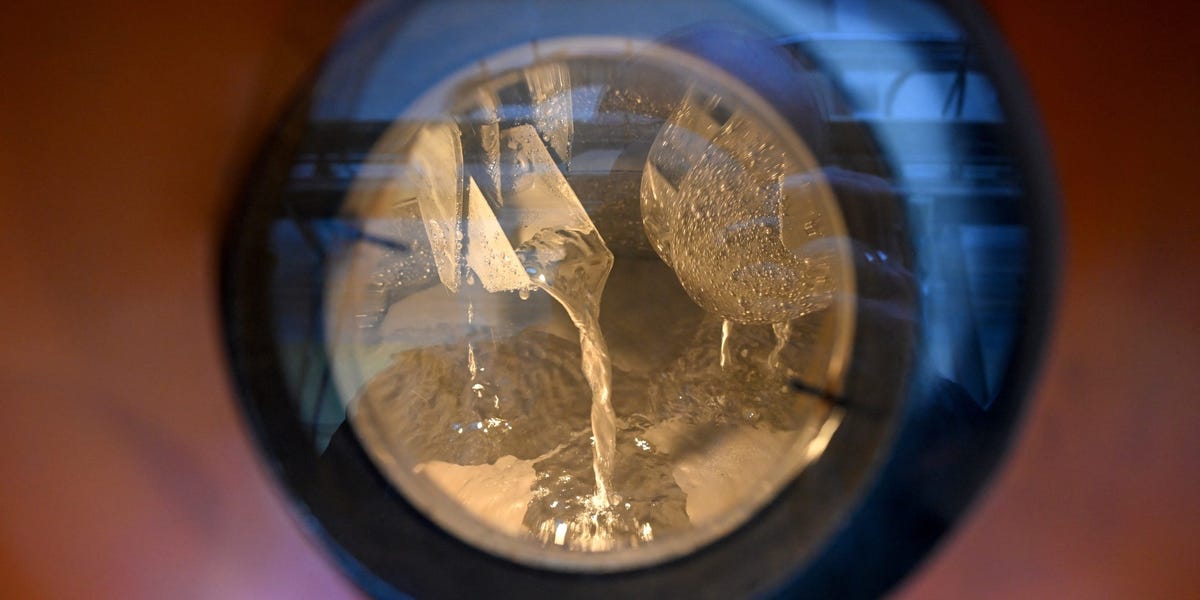One study suggested that the reactors could produce more nuclear waste than current systems and that they “will use highly corrosive and pyrophoric fuels and coolants that, following irradiation, will become highly radioactive.”
Pyrophoric (adj) – Liable to ignite spontaneously on exposure to air.
Just in case you weren’t entirely sure what that word meant either.
That sounds fun when combined with radioactivity.
deleted by creator
Money? Yeah it sure feels that way around this time of year if you’ve got a family.
highly corrosive and pyrophoric fuels and coolants that, following irradiation, will become highly radioactive
How true is this? Because a highly radioactive and highly corrosive material that like to catch fire spontaneously - well, that just doesn’t sound like a good idea, yet obviously some people are considering it. What am I missing?
If you can work it properly, molten salt reactors are MUCH safer and more efficient, because the waste heat from fission products cannot cause a problem with something cooled through convection and conduction of a molten salt. You can’t really have a destructive meltdown when the coolant doesn’t care if the fuel melts. The problem is, most previous attempts ended up with the reactor catching on fire. Not a dangerous fire, exactly, but generally not the outcome you’re looking for.
On the waste front, neutron activation of water produces tritium at worst, which you dispose of by putting it into a bigger body of water. Neutron activation of the molten salt coolant can be more difficult to dispose of, but it’s not exactly a major problem.
If we could use the tritium that would be helpful, it’s limited on earth and our only known source off world is in lunar regolith. Plus it’s part of the fuel needed to begin a fusion reaction.
It’s not a lot of it and isolating it is more trouble than it’s worth. It’s easier to just create a lithium channel that creates it when it’s neutron activated. That or isolating it from a heavy water reactor, since that produces a whole lot more.
Tritium isn’t scarce, in that we really can create it pretty easily. Lithium-6 is available to do so if needed. (https://isotope.com/en-us/lithium-6-metal-li-95-pct-llm–827–pk). It’s jut not economical to produce for most purposes.
Edit: Also, it’s not tritium in the regolith but He3, which is theorized as an aneutronic (thus much cleaner and not creating a bunch of neutron activation waste like tritium fusion would create) fusion fuel but nobody’s really achieved fusion with it. Tritium would’ve decayed if it was in the regolith.
When you let tritium decay, it creates He3.
“Salt as a coolant is just superior to water, once you’ve got the engineering details hammered out,” Smith told BI.
You’re missing the “engineering details” I guess
Is that like the whole “magic occurs here” thing that I also never quite got?
Sounds like you get it now ;)
"“engineering details” is usually code for “very expensive”.
deleted by creator
This is the best summary I could come up with:
To prevent the water from evaporating and keep it a liquid at such high temperatures requires a lot of pressure, which in turn costs additional technology, space, and money.
“You can utilize it at these high temperatures, and it doesn’t boil,” Nicholas V. Smith, project director of the molten chloride reactor experiment at the Idaho National Laboratory, told Business Insider.
The first molten salt reactor tested in the 1950s, for example, was small enough to fit on a plane whereas the portion of the Diablo Canyon Nuclear Power Plant in California that generates energy takes up 12 acres of land, according to Berkeley Engineering.
Kairos Power is the company that plans to build a test plant it calls Hermes, which will be cooled by molten fluoride salt in Oak Ridge, Tennessee by 2027.
Because molten salt reactors don’t need those thick pressure vessels to keep water a liquid at high temperatures, there’s more design flexibility, Smith said.
“I see molten salt reactors as being prolifically deployed in all areas,” from remote locations to shipping vessels to large power plants, he added.
The original article contains 714 words, the summary contains 181 words. Saved 75%. I’m a bot and I’m open source!
It will never be built, it will go the way of all nuclear “innovations” and die expensively.
What is it with my nation? If you are the last person to die with all the money, what have you actually won?
Read the article, the OP only quoted the part that talked about the downsides
It’s about developing small, safe reactors
Ostensible reasons.* are different from reasons. Go deeper.
*Autocorrect cracks me up, sometimes
Why is this about nuclear and not solar thermal?
deleted by creator
because they mix the fuel into the salt
As a billionaire, you can’t fire all your workers without AI. And you can’t have AI without lots of electricity. The planet and its people don’t matter. Profits matter.
Why can’t this country build a modern reactor? Why do we keep investing in outdated, polluting-style nuclear energy?
Molten Salt reactors are great at recycling spent uranium and don’t really cause pollution. If anything they reduce pollution because they create less nuclear garbage.
Over here in Germany it has already shown that you can’t fully replace nuclear power with green power. What you instead get if you try to shut down all the nuclear reactors is an increase in coal fossil fuel based plants, which are far worse for the environment
So, do you want nuclear power and have us learn how to recycle nuclear waste, or do you want to abolish nuclear power and have us return to fossil fuels? These are your only two options.
I want to get off Mr. Bones’ Wild Ride.
Molten Salt reactors are great at recycling spent uranium and don’t really cause pollution. If anything they reduce pollution because they create less nuclear garbage.
If it was that big of a problem folks would be doing PUREX reprocessing with all nuclear fuel. Not a clean process, but reduces the overall mass problem you have with spent fuel rods. No matter what you do, you just can’t burn off the fission products that last forever and ever. You can put them in a container the size of a coffee can that still emits a similar amount of radiation as a whole rod if you want, but I’m not sure I see the utility. They just take those and vitrify them to make them bigger to take advantage of the inverse square law and make them safer to handle.
As long as uranium stays cheap, neither reprocessing, breeders, or reactors that eat the plutonium they produce really makes sense. You still need a similar site to store the waste regardless. As it stands I don’t think we’ll see uranium being a significant part of running a reactor in the foreseeable future. (As long as you’re not a nuclear weapons state that doesn’t have a robust fuel enrichment program, like India).
This kind of reactor could be installed on cargo ships
Sounds like it will be a “modern” reactor that uses molten salt as coolant instead of water. I wonder what they’ll make the coolant loops out of: steel glows at 900 deg Freedom.
I wonder what they’ll make the coolant loops out of: steel glows at 900 deg Freedom
That’s always been the problem with the reactors. High heat, corrosion resistant, and resistant to neutron spallation is a very very tall order.
Just use Duranium, duh
You would use materials that perform completely fine at those temps. This could be anything from high nickel alloy steel, to Inconel, to an HEA (high entropy alloy). You can even do high heat resistant metals with ceramic coatings on the inside for protection if creating a passivation layer is too difficult for the application or the exposure environment does not allow for one to form.
There is an entire subsection of engineering studies focused on purely coaxing specific properties out of a material or developing materials to custom suit extreme applications, known as material science. They generally work very closely with chemical engineers (my background) and metallurgists in order to manufacture the designed product in either batch form, or in continuous fashion.
I work in a steel mill and we have Inconel furnace rolls that hang out in 1600 F heat 24/7 and are rated (iirc) to ~2300F max operation temp. For reference medium carbon steel melts between 2600 and 2800F, and loses a lot of its mechanical strength well before 2300F (I am trying to find a stress strain curve for carbon steel over multiple temperatures for reference. I will update if I find one)
Edit: Okay so I found one that does show what I am trying to convey. As you can see, the higher the temperature of the sample material, the lower the yield strength. Example: the 100C sample was strained to >25% before failure, while the 700C sample began to plastically deform (fail) before 10% strain. Take note of the second link, all the test temperatures are MUCH higher than any of the carbon steel samples
Carbon Steel Curve: https://www.researchgate.net/figure/Stress-strain-curves-at-different-temperatures-for-steel-4509-2_fig11_236341600
Inconel Curve: https://www.researchgate.net/figure/Stress-strain-curves-of-Inconel-625-alloy_fig11_338984803
Everything starts to glow north of 900, but your point stands
The last try at a modern reactor in the US started around 2009, was supposed to cost $14 billion, and was supposed to be operational 7 years later in 2016.
Instead, it wound up costing over $30 billion and just now became operational.
In other words, it was a total shit show. No one likes to risk that much time and money very easily.
Smaller and cheaper reactors that shouldn’t take decades to build are a lot more palatable to the people putting up the money.
Cause some rich fuck or fucks have their hand(s) so far up politician’s asses that progress is slowed by their own greed and ineptitude
Thorium salt reactors are great, what’s your hangup? Even the dirtiest reactor has a better track record than any other form of power including solar.







